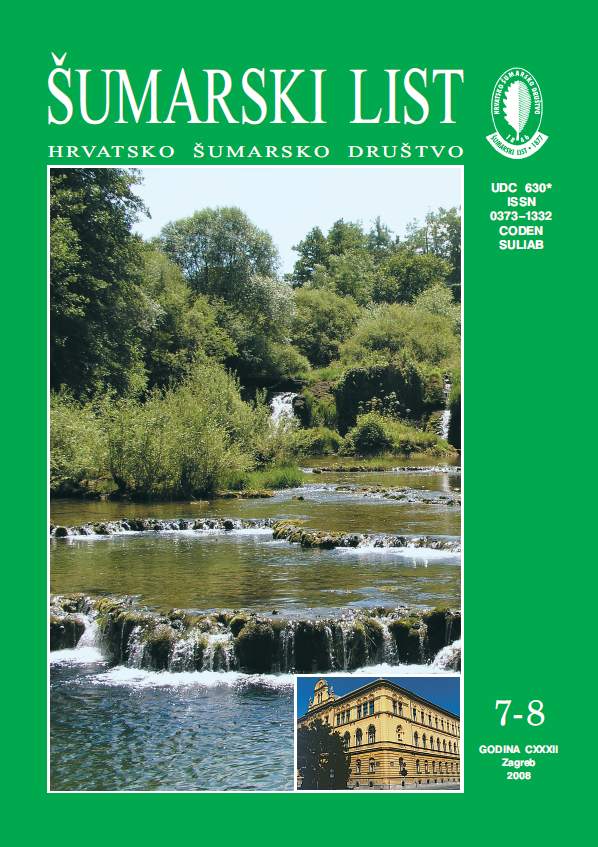
broj: 7-8/2008
pdf (15,2 MB) |
|
||||||||||||||
| IZVORNI ZNANSTVENI ČLANCI | ||
| Tomić, F., T. Krička, S. Matić | UDK 630* 331 + 88 (001) | |
| Available Agricultural Areas and the Use of Forests for Biofuel Production in Croatia pdf HR EN | 323 | |
| Summary: The production and expansion of biofuel use in the world and the EU has been prompted by economic and ecological reasons. Fossil fuel reserves (oil and gas) are being depleted and becoming more expensive. At the same time the Kyoto Protocol stipulates the reduction of greenhouse gas emissions with the goal of mitigating climatic phenomena which could cause unforeseen consequences. Land for biomass production is limited: therefore, biofuels could, following the EU strategy, replace fossil fuels only in one part. In addition to developing other renewable energies (hydro energy, solar energy, wind energy, geothermal energy), the EU committed itself to replace traffic oil with biofuels by 25 % by the year 2030. As Croatia is an EU membership candidate, the first thing it is required to do is to fulfill the obligation of achieving a 5.75 % proportion of biofuels (104,034 tons), held by each member state, by the year 2010. This is followed by the fulfillment of the commitment for the year 2020 (180,930 tons) and by the year 2030 (452,325 tons). Of the total continental land area of Croatia (5,662,031 ha), agricultural land covers 2,955,728 ha or 52.2 %. In Croatia, 55.9% or 1,202,000 ha of a total of 2,150,000 ha of potentially arable land are cultivated. If pastures are excluded, then arable land amounts to only 50.8 % or 1,092,000 ha. With the application of more or less intensive ameliorative measures, agrocultures could be cultivated for food production and partially for biofuel production over as many as 947.080 ha of available land in Croatia. Permanently unsuitable land for agricultural production in Croatia amounts to 806,328 ha. This land could be used for the establishment of forest cultures where timber for industry and bioenergy could be produced. The current conditions in Croatia give us reason to believe that there are good possibilities for biodiesel production from rape seed (especially rape oil) using first generation technologies, and biodiesel from lignocellulose biomass and its residues in agriculture and forestry with the application of second generation technologies. Moreover, a large number of cattle farms in Croatia produce large quantities of organic residue (especially animal manure) which could be usefully converted into biogas for both economic and ecological reasons. The quantity of biomass from agrocultures amounts to 1,239,550 (t) annually, which is only 30 % of their value. The remaining 70 % of the biomass should be left on agricultural land to allow organic matter in the soil to regenerate naturally. The total equivalent value in crude oil from agricultural areas is 428,992 t/annually. Apart from biomass from agricultures, significant biomass quantities also exist in cattle breeding. Animal manure and organic residue from cattle are used for biofuel production – biogas. Annual quantities of overall animal manure in Croatia amount to 381,480,000 t and represent 25 % of the existing annual quantities. This biomass quantity (organic residue in husbandry) may provide a total of 244,538 t of annual equivalent values of crude oil. Present agricultural production may provide 673,530 t/annually of biofuels from biomass (organic residue and waste) in the equivalent value of crude oil without jeopardizing permanent natural regeneration of organic matter in the soil. Croatia possesses 2,688,687 ha of forests and forestland with 397,963,000 m3 of growing stock which increments annually by 10,526,000 m3. The annual cut or the prescribed cut is 6,564,000 m3 of gross volume. Of the total annual cut, about 40 % or 2,625,600 of timber is used for processing, 20 % or 1,312,800 m3 for of fuelwood for energy and the remaining 40 % or 2,625,000 m3 is left in the forest as waste. Of this residue, 62.5 % or 1,641,000 m3 could be used for bioenergy production, while 37 % or 984,000 m3 would remain in the forest as waste. If this amount suitable for bioenergy is added to the quantity of 1,312,800 m3 of fuelwood, the total quantity of energy wood that could already be placed on the energy market amounts to 2,953,800 m3, which is 45 % of the total annual cut. This quantity could provide 600,000 t/annually of biofuel in the equivalent value of crude oil. Therefore, Croatia can produce an annual biofuel quantity of 1,273,539 t from the existing reserves in agriculture and forestry. This amount is 2.8 times higher than the quantity (452,325 t) which Croatia is obliged to use in traffic instead of fossil fuels by 2030 (the EU Directive of 2003). Taking into account realistic potential possibilities of biofuel production in agriculture and forestry, we believe that a strategy on biomass use and biofuel production should be developed in Croatia with the goal of achieving economic and ecological bene. | ||
| Sučić, I. | UDK 630* 156 (001) | |
| Rock – Partridge (Alectoris Graeca Meisner) Population Size on Mountain Tušnica in the Period between 2000 and 2007 pdf HR EN | 331 | |
| Hukić, E., A. Dounavi, D. Ballian | UDK 630* 165 (001) | |
| Dna Analysis of London Planetree of Tree Lined Walkways of the City of Sarajevo pdf HR EN | 337 | |
| STRUČNI ČLANCI | ||
| Pintarić, B. | UDK 630* 165 | |
| Micropropagation of White Poplar (Populus alba L.) pdf HR EN | 343 | |
| Frković, A. | UDK 630* 902.1 + 648 + 156 | |
| Josip Ettinger – The First Croatian Zoologist pdf HR EN | 355 | |
| Prebježić, P. | UDK 630* 907 | |
| Spatial Presentation of Diameter Class Series from the First Measurement of the Permanent Plot in “Čorkova Uvala” Virgin Forest in 1957 pdf HR EN | 363 | |


